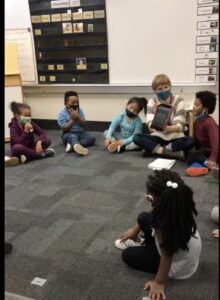
Written by Erin Moulton, Co-Director of Teaching Preschool Partners and reviewed by Joelle Flegal, Kindergarten Teacher at Gladstone Center for Children and Families
In 2021, school doors slowly opened to welcome masked children and teachers back into school buildings, but families were still kept at a distance. For the obvious reasons of course, to mitigate exposure and to keep people as safe as possible. One teacher that I worked with, Joelle Flegal, at Shaver Teaching Preschool, held families at the center of her work with children. She knew that the family school connection was vital to helping children feel belonging. Knowing families and having families know the school community allows children to enter into the classroom more at ease and more open to connection. These connections and feeling of community are what set the stage for relaxed alertness ripe for learning.
Determined to keep that connection alive Joelle greeted families as they returned from the isolation of the pandemic with her Ipad in hand. She asked families one at a time if they would be comfortable with her filming them introducing themselves to the children in their home languages. Back in the classroom over the course of many weeks, Joelle played the videos of one family at a time greeting the classroom of students. To many students’ delight they saw their families on the big screen, for some of the children it was the only time that they were able to hear their home language actually spoken in the classroom.

I will never forget one morning when a jubilant 3 year old child ran circles around the room at hearing her father saying, kamay ḥādirǝkum (good morning in Tigrinya) and her classmates trying repeatedly to say it back to each other. Her joy was contagious and she giggled excitedly. Despite the absence of the family’s physical presence in the classroom and time spent playing together on the playground outside of school, there was a sense of community. Children were getting to know one another’s families and a small piece of each child’s language and culture. Communicating through a quick wave as they passed at pick up or in the echoing of kamay ḥādirǝkum as they arrived in the morning.
I often reflect on this small, simple act Joelle took to reach out to families when so many were feeling disconnected. It was simple, yet powerful! Now almost 4 years later families still rarely enter the school doors at some schools. Drop off has been streamlined into car pick up lines, playgrounds have been locked after hours, and family photos let alone volunteers are rare in classrooms. I wonder what might happen if we opened the real and virtual school doors once again, if we found ways for families to be a part of the school day in person or virtually before, during and after school, whenever it works for them. Families lead busy lives, many working multiple jobs and are not available during the school day. Might Joelle’s video introductions be a strategy to continue even now to help break down barriers that separate children’s lives at school and at home? What might happen if a family member who has never set foot on campus is recognized by another child in the grocery store or at the park and greeted in their home language?
What might be possible for our schools and larger communities if we feel seen and heard and told we belong starting with our children?
Shaver Teaching Preschool is a collaboration between the Parkrose Public School District, Teaching Preschool Partners and Preschool Promise. Preschool Promise is an education initiative of Oregon’s Early Learning Division with the purpose of increasing access to quality preschool education and enhancing early learning practices in existing early education programs for preschool-age children in Oregon. Preschool Promise funds are distributed through early learning hubs located throughout the state. The Parkrose district was selected to receive Preschool Promise funds for its program at Shaver Elementary as it serves the population that PSP is striving to serve. Children are eligible to enroll in Shaver Teaching Preschool if they are members of families whose incomes are at or below 200% of the Federal Poverty Guidelines. This preschool classroom is located within Shaver Elementary School of the Parkrose Public School District. It currently serves 18 children who attend six hours each school day, Monday through Friday.